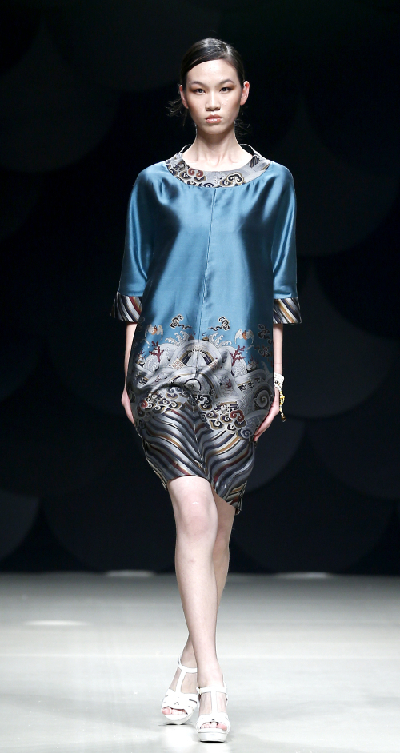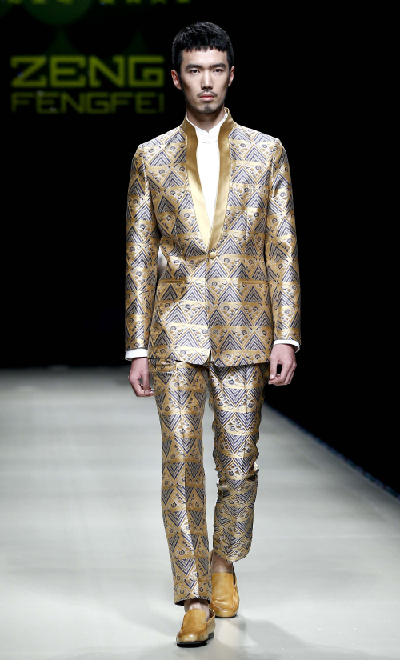|
 |
|
ELEGANT DRESS: A model presents Zeng Fengfei's collection at Beijing Fashion Week on October 28, 2014 (CHEN JIANLI) |
Brocades and satin were chosen. These fabrics are luxurious but not showy, suitable to make formal dress for leaders. "This style of traditional Chinese dress can be tailored for different occasions," Zeng said.
Nonetheless, since the fabrics are expensive and the technology is complicated, the costumes for APEC leaders are pricy. Zeng said that he will choose materials and designs to make the dresses affordable.
He believes that adequate market positioning is the life of China's tailor-made clothing industry. Unlike the haute couture abroad, tailor-made clothing in China are of high quality yet the prices are not "beyond reach," he said.
Zeng grew up in a fishing village in Xiapu County, southeast China's Fujian Province. When he was a child, he dropped out of school because of family hardship, and then fished for more than 10 years.
He liked painting, and often drew pictures in the sand with a stick. His elder sister was a seamstress, so he learned to sketch clothing designs. Later, he left the fishing village to work as a librarian in the library of Xiamen University, where he spent most of his spare time reading.
In 1993, he began to study in the Academy of Art and Design of Tsinghua University. Upon finishing his studies, he set up his own work studio, and has since worked as a fashion designer for more than two decades.
In 2008, he created his own brand FENGFEI?Z and in 2014, he opened a haute couture center. He is reputed as the leading design for Chinese style men's clothing.
While Zeng specializes in male clothing, Guo Pei mainly designs for women. Her clients include famed hostesses, actresses and athletes in China.
She has designed costumes for hostesses and artists performing at the annual Chinese New Year Gala of China Central Television, a highlight of the festival viewed by millions of Chinese at home and abroad.
Guo has also designed dresses worn at various ceremonies for the 2008 Beijing Olympic Games, including the outfit actress Zhang Ziyi wore in Greece to initiate the torch relay and the elaborate dress worn by singer Song Zuying at the closing ceremony.
Some of her clients are international, such as singer Lady Gaga and supermodel Carmen Dell'Orefice.
Guo designed her first clothes when she was a child. In 1982, she went to university to study fashion design.
Guo has worked as the lead designer for several clothing companies. While she worked for Beijing Tianma Clothing Co., the company registered annual sales exceeding 3.9 billion yuan ($629 million), and rose to become one of China's top 10 clothing brands.
In the 1980s, while most people in China earned no more than 100 yuan ($16) per month, Guo made more than 10,000 yuan ($1,600). In 1997, she founded her own company. For 10 years, she worked diligently behind the scenes, expanding her business. In addition to high-end dresses, she also designed swimsuits, pajamas, underwear, headwear and shoes.
To produce exquisitely made clothing with the best materials, Guo sometimes disregarded the costs entirely.
At the closing ceremony of the 2008 Olympics in Beijing, singer Song dazzled the audience with her beautiful voice and a splendid long robe studded with more than 200,000 Swarovski crystals.
Guo said that she hired a dozen people who worked on day and night shifts to finish the dress within a two-week deadline. It can take up to two years to finish a piece of haute couture clothing, so its value cannot be measured by money, Guo said.
"In the beginning, I worked hard to make a garment look pretty by using the best fabric and design while neglecting its implication," Guo said.
She said that haute couture is an art that expresses our understanding of life. "Every piece is meticulously made with our hands and heart. The time in our life has gone into every piece of clothing, so that it has acquired a life of its own," she mused.
To make exceptional haute couture, one should create outer beauty from within, she believes.
She said that as a Chinese fashion designer, she is proud to present her country, culture and people to the world.
 |
|
ELEGANT DRESS: A model presents Zeng Fengfei's collection at Beijing Fashion Week on October 28, 2014 (CHEN JIANLI) |
Email us at: tangyuankai@bjreview.com | 